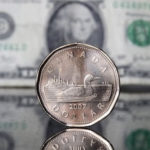Yesterday’s trade saw USD/CAD within the range of 1.2662-1.2798. The daily high was a test of the high recorded on January 30th. The pair closed at 1.2752, up 0.50% on a daily basis and extending gains from Wednesday.
At 9:12 GMT today USD/CAD was down 0.38% for the day to trade at 1.2698. The pair touched a daily low at 1.2679 at 7:55 GMT.
Fundamentals
United States
Initial Jobless Claims
The number of people in the United States, who filed for unemployment assistance for the first time during the week ended on March 6th, probably decreased to 305 000 from 320 000 in the prior week. The latter has been the highest level since the week ended on May 17th 2014. The 4-week moving average, an indicator lacking seasonal effects, was 304 750, marking an increase of 10 250 from the previous weeks unrevised average of 294 500.
Initial jobless claims number is a short-term indicator, reflecting lay-offs in the country. In case the number of claims fell more than projected, this would have a bullish effect on the greenback.
The number of continuing jobless claims probably rose to the seasonally adjusted 2 500 000 during the week ended on February 27th. If so, this would be the highest number of claims since the week ended on November 28th, when 2 520 000 claims were reported. In the week ended on February 20th there were 2 421 000 claims. The latter represented an increase by 17 000 compared to the revised up number of claims, reported during the week ended on February 13th. This indicator reflects the actual number of people unemployed and currently receiving unemployment benefits, who filed for unemployment assistance at least two weeks ago.
The Department of Labor is to release the weekly report at 12:30 GMT.
Retail Sales
Retail sales in the United States probably rose 0.3% in February on a monthly basis, according to the median forecast by experts. In January retail sales recorded a 0.8% drop, which has been the largest monthly decrease since May 2010, when sales fell 1.1%. This result was due to smaller receipts at car dealers, gasoline stations and clothing stores. Receipts at gasoline stations went down 9.3% in January, after another 7.4% decrease in December. Sales at automobile dealers were 0.5% lower during January, following a 0.8% drop in December, while sales at food and beverage stores declined 0.3% during the same period, according to the report by the US Census Bureau.
Annualized retail sales climbed 3.3% in January, following a 3.2% gain in December.
The report on retail sales reflects the dollar value of merchandise sold within the retail trade by taking a sampling of companies, operating in the sector of selling physical end products to consumers. The retail sales report encompasses both fixed point-of-sale businesses and non-store retailers, such as mail catalogs and vending machines. The Census Bureau, which is a part of the Department of Commerce, surveys about 5 000 companies of all sizes, from huge retailers such as Wal-Mart to independent small family firms.
US core retail sales, or retail sales ex autos, probably went up 0.5% in February compared to a month ago, following a 0.9% drop in January. This indicator removes large ticket prices and historical seasonality of automobile sales.
The retail sales index is considered as a coincident indicator, thus, it reflects the current state of the economy. It is also considered a pre-inflationary indicator, which investors can use in order to reassess the probability of an interest rate hike or cut by the Federal Reserve Bank. In addition, this indicator provides key information regarding consumer spending trends. Consumer expenditures, on the other hand, account for almost two-thirds of the US Gross Domestic Product. Therefore, a larger-than-expected rate of increase in sales would certainly boost the US dollar. The official report is due out at 12:30 GMT.
Canada
New Housing Price Index
Selling prices of new homes in Canada probably rose for a sixth straight month in January compared to December, up 0.1%, according to market expectations. In December compared to November there was another 0.1% increase in prices. Home values climbed at a rate of 1.7% in December compared to December 2013, or matching the annual rate in November, while also being the fastest rate since August 2013. The New Housing Price Index is a key indicator, reflecting the health of Canadian housing market. In case prices surged more than anticipated, this would be an indication of a strong demand and would, therefore, have a bullish effect on the loonie. Statistics Canada will release the official data at 12:30 GMT.
Pivot Points
According to Binary Tribune’s daily analysis, the central pivot point for the pair is at 1.2737. In case USD/CAD manages to breach the first resistance level at 1.2813, it will probably continue up to test 1.2873. In case the second key resistance is broken, the pair will probably attempt to advance to 1.2949.
If USD/CAD manages to breach the first key support at 1.2677, it will probably continue to slide and test 1.2601. With this second key support broken, the movement to the downside will probably continue to 1.2541.
The mid-Pivot levels for today are as follows: M1 – 1.2571, M2 – 1.2639, M3 – 1.2707, M4 – 1.2775, M5 – 1.2843, M6 – 1.2911.
In weekly terms, the central pivot point is at 1.2552. The three key resistance levels are as follows: R1 – 1.2699, R2 – 1.2777, R3 – 1.2924. The three key support levels are: S1 – 1.2474, S2 – 1.2327, S3 – 1.2249.





